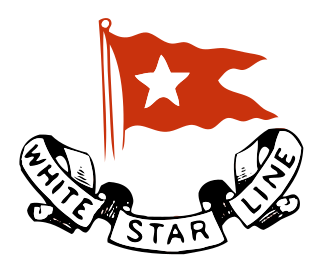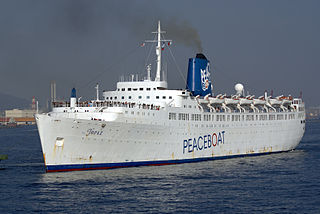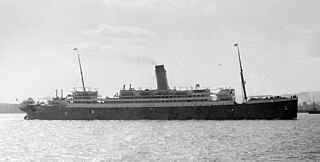
The Oceanic Steam Navigation Company, more commonly known as the White Star Line (WSL), was a British shipping company. Founded out of the remains of a defunct packet company, it gradually rose up as one of the most prominent shipping lines in the world, providing passenger and cargo services between the British Empire and the United States. While many other shipping lines focused primarily on speed, White Star branded their services by focusing more on providing steady and comfortable passages, for both upper class travellers and immigrants. Today, it is most famous for the innovative vessel Oceanic of 1870, and for the losses of some of their best passenger liners, including the wrecking of RMS Atlantic at Halifax in 1873, the sinking of RMS Republic off Nantucket in 1909, the loss of RMS Titanic in 1912 and HMHS Britannic in 1916 while serving as a hospital ship. Despite its casualties, the company retained a prominent hold on shipping markets around the globe before falling into decline during the Great Depression, which ultimately led to a merger with its chief rival, Cunard Line, which operated as Cunard-White Star Line until 1950. Cunard Line then operated as a separate entity until 2005 and is now part of Carnival Corporation & plc. As a lasting reminder of the White Star Line, modern Cunard ships use the term White Star Service to describe the level of customer care expected of the company.

German submarine U-32 was a Type VIIA U-boat of Nazi Germany's Kriegsmarine during World War II.

The Fairfield Shipbuilding and Engineering Company, Limited was a Scottish shipbuilding company in the Govan area on the Clyde in Glasgow. Fairfields, as it is often known, was a major warship builder, turning out many vessels for the Royal Navy and other navies through the First World War and the Second World War. It also built many transatlantic liners, including record breaking ships for the Cunard Line and Canadian Pacific, such as the Blue Riband-winning sisters RMS Campania and RMS Lucania. At the other end of the scale Fairfields built fast cross-channel mail steamers and ferries for locations around the world. These included ships for the Bosporus crossing in Istanbul and some of the early ships used by Thomas Cook for developing tourism on the River Nile.

CP Ships was a large Canadian shipping company established in the 19th century. From the late 1880s until after World War II, the company was Canada's largest operator of Atlantic and Pacific steamships. Many immigrants travelled on CP ships from Europe to Canada. The sinking of the steamship RMS Empress of Ireland just before World War I was the largest maritime disaster in Canadian history. The company provided Canadian Merchant Navy vessels in World Wars I and II. Twelve vessels were lost due to enemy action in World War II including the largest ship sunk by a German U-boat, RMS Empress of Britain.

The RMS Empress of Britain was an ocean liner built between 1928 and 1931 by John Brown shipyard in Scotland and owned by Canadian Pacific Steamship Company. This ship was the second of three CP vessels named Empress of Britain — provided scheduled trans-Atlantic passenger service from spring to autumn between Canada and Europe from 1931 until 1939.

RMS Majestic was a White Star ocean liner working on the North Atlantic run, originally launched in 1914 as the Hamburg America Line liner SS Bismarck. At 56,551 gross register tons, she was the largest ship in the world until completion of SS Normandie in 1935.

RMS Empress of Britain was a transatlantic ocean liner built by Fairfield Shipbuilding at Govan on the Clyde in Scotland in 1955-1956 for Canadian Pacific Steamships (CP). This ship — the third of three CP vessels to be named Empress of Britain — regularly traversed the trans-Atlantic route between Canada and Europe until 1964, completing 123 voyages under the Canadian Pacific flag.

HMCS Lady Evelyn was a commissioned patrol boat of the Royal Canadian Navy during the First World War. Originally built as a passenger liner, Deerhound, she was acquired in 1907 by the Canadian government and renamed Lady Evelyn for use by the post office. After the war, she was sold for civilian service and scrapped in 1936.
RMS Empress of Canada may refer to one of the following ships of the Canadian Pacific Steamship Company:
German submarine U-221 was a Type VIIC U-boat of Nazi Germany's Kriegsmarine during World War II.

RMS Empress of Japan was an ocean liner built in 1929–1930 by Fairfield Shipbuilding & Engineering Company at Govan on the Clyde in Scotland for Canadian Pacific Steamships (CP). This ship was the second of two CP vessels to be named Empress of Japan – regularly traversed the trans-Pacific route between the west coast of Canada and the Far East until 1942.
Empress of Scotland may refer to one of these Canadian Pacific Steamships ocean liners:
German submarine U-30 was a Type VIIA U-boat of Nazi Germany's Kriegsmarine that served during World War II. She was ordered in April 1935 in violation of the Treaty of Versailles, which prevented the construction and commissioning of any U-boats for the German navy, and as part of the German naval rearmament program known as Plan Z. She sank the liner SS Athenia, the first ship sunk in World War II, on 3 September 1939, under the command of Fritz-Julius Lemp. She was retired from front-line service in September 1940 after undertaking eight war patrols, having sunk 17 vessels and damaging two others. U-30 then served in a training role until the end of the war when she was scuttled. She was later raised and broken up for scrap in 1948.

SS Mégantic was an ocean liner built by Harland and Wolff, of Belfast, and operated by the White Star Line. The liner was launched in 1908 and was 14,878 gross register tons (GRT). The ship was attacked by a German U-boat during World War I, but survived. Mégantic was taken out of service in 1931 and scrapped in 1933.

RMS Empress of India was an ocean liner built in 1890-1891 by Naval Construction & Armaments Co, Barrow-in-Furness, England for Canadian Pacific Steamships. This ship would be the first of two CP vessels to be named Empress of India, and on 28 April 1891, she was the very first of many ships named Empress arriving at Vancouver harbor.

RMS Empress of Scotland, originally SS Kaiserin Auguste Victoria, was an ocean liner built in 1905–1906 by Vulcan AG shipyard in Stettin for the Hamburg America Line. The ship regularly sailed between Hamburg and New York City until the outbreak of war in Europe in 1914. At the end of hostilities, re-flagged as USS Kaiserin Auguste Victoria, she transported American troops from Europe to the United States. For a brief time Cunard sailed the re-flagged ship between Liverpool and New York.
RMS or SS Empress of China may refer to one of these Canadian Pacific Steamship Company ocean liners:
RMS or SS Empress of India may refer to one of these Canadian Pacific Steamship Company ocean liners:
An Empire ship is a merchant ship that was given a name beginning with "Empire" in the service of the Government of the United Kingdom during and after World War II. Most were used by the Ministry of War Transport (MoWT), which owned them and contracted their operation to various shipping companies of the British Merchant Navy.
SM U-62 was one of the 329 submarines serving in the Imperial German Navy in World War I. U-62 was engaged in the naval warfare and took part in the First Battle of the Atlantic.











